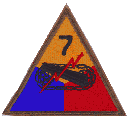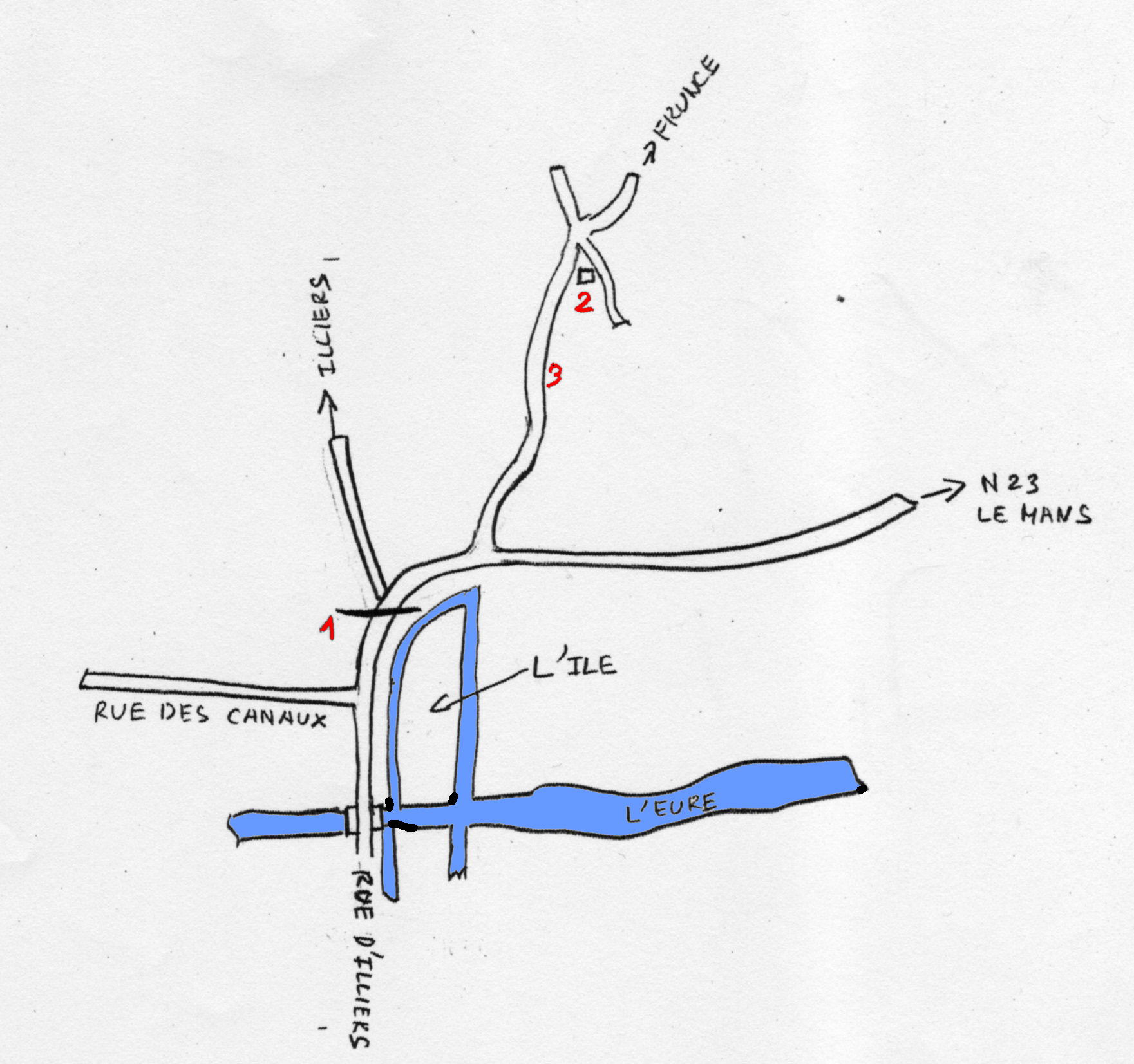

 1 - Line of German resistance 2 - Isolated house hit by German fire 3 - Approximate place where Lt. J. Gomer was killed. Click on map for larger image. |
 Frédéric Hallouin's article in Courville-sur-Eure Infos no. 39 Click on image for PDF file of 2-page article. See English translation below. |
|
Courville historian Frédéric Hallouin researched the death in Courville of 1st Lt. James O. Gomer, the first member of the 23rd Armored Infantry Battalion to be killed in combat. In April 2012, he wrote an article about his research for the Courville-sur-Eure magazine Infos (see above). The following is the English translation of the article, with annotations by 7th Armored Division Association Historian Wesley Johnston. |
|
A Young Soldier, 23 Years Old, Came from the Other Side of the Atlantic and Fell for Our Liberty
James Ollie [Wesley Johnston note: After the article was written, we learned his actual middle name is Otis and not Ollie.] Gomer was born September 13, 1921. His parents Ollie B. and Jane M. Gomer lived at 2116 North Main in Poplar Bluff, Missouri. He lived with his wife Edna A. at Corning, Arkansas. Thanks to a fishing license recovered in his personal effects and sent to his wife, we know one of his passions. He entered active service 16 November 1942 and reached the rank of 1st Lieutenant. His service number was O-1300020. [Wesley Johnston note: He actually entered service 23 December 1940 as a Pfc, based on prior National Guard duty, with the service number 20 731 929. His commission as an officer and assignment of an officer’s service number took place 16 November 1942.] He commanded a section of reconnaissance [WJ: He actually commanded the entire Reconnaissance Platoon.] of the 23rd Armored Infantry Battalion, 7th Armored Division. Killed the evening of 14 August 1944 by small arms fire, he was first buried at St. Corneille 16 August 1944. His remains were transferred in Marcy 1949 to the American Military Cemetery at St. James (Section B, Row 16, Grave 5) where he still rests, his family not having requested the repatriation of his remains. The current state of our research has not permitted us to obtain a photograph of James. We are in contact with the American 7th Armored Division Association who are searching in this regard. |
|
7th Armored Division Attached to XX Corps
The 7th Armored Division under command of Major General Lindsay MacDonald Silvester, attached to XX Corps was an American unit freshly created 1 September 1942. The Division arrived in Great Britain from 13 June 1944 and settled around Grenock, Scotland. [WJ: The Division debarked at Grenoch but immediately went by train to Tidworth Barracks in Wiltshire, England.] Deployed in France, the Division debarked on Utah Beach 10 August 1944. [WJ: Actually, elements of the Division debarked on both Omaha and Utah Beaches, beginning 10 August 1944.] In fact, they had no combat experience. Their baptism of fire will indeed take place at Courville. [WJ: Actually, some elements of the Division saw their first combat at Senonches, west of Courville. The Division had split into two routes, with the eastern one coming to Courville.] The liberation of Chartres would be their first true test. Their hour of glory would come at the terrible Battle of the Ardennes in the area of St. Vith, Belgium. Escaping destruction, the Division earned the nickname “Lucky Seven”. An armored division of this type had in its ranks 10,937 men, 162 M4 assault tanks, 66 M5 light tanks, 36 M8 armored cars, 8 self-propelled 75mm howitzers, and 54 self-propelled 105mm howitzers, divided into 3 tank battalions, 3 artillery battalions, a reconnaissance squadron and 3 infantry battalions and all services necessary for the proper operation of mass of materiel and men. The 23rd Armored Infantry Battalion was one of the three infantry battalions of the Division. It was transported by half-track. |
|
TRIBUTE TO First Lieutenant JAMES GOMER
15 August 1944 the wind of liberty blew upon our town after more than four long years of occupation. Monday – 14 August, eve of the Feast of the Assumption. In this late afternoon, the atmosphere was heavy, national route 23 which traverses our town seemed calm. The passage a few days earlier of columns of automobiles had given way to convoys of horse-drawn vehicles then to groups, more or less supervised, of soldiers on foot. The long-awaited freedom seemed near. The Allies debarked the morning of 6 June had been blocked 70 days by a German army fighting foot by foot, with no thought of retreat, transforming the luxuriant and peaceful countryside of Normandy into a battlefield and its towns into ruins. Operation Cobra – launched 24 July finally broke the German defense and opened a breach. Thus, the Third Army of the charismatic General Patton was able to enter the scene. Launching its three Corps toward Brittany, and the regions of Orleans, and Droux to reach the Seine quickly, his legendary drive would not be stopped except for lack of fuel in Lorraine. During this time, our citizens held their breath. Nogent-le-Retrou had been liberated 11 August by the Maquis from Plainville. The BBC announced the same day that the city of Chartres had been reached by elements of the American army. A message of hope for the population or a toxic message to hasten the German retreat? The American Army Arrives In the afternoon of the 14th, about 5 PM, the 23rd Armored Infantry Battalion left Cormes, after having bivouacked there. Its mission was to advance as far as possible toward Chartres, which the general staff had not given up hope of reaching by that same evening. Avoiding national route 23, already in use by other elements of the Division marching on la Loupe, 23 AIB followed the route Authon-du-Perche, Beaumont-les-Autels, Argenvilliers, Thirons-Gardais, Combres, St. Denis-des-Puits, and reached southern Courville by 8:30 PM. A German Army in Retreat but not Routed If the Germany army retreated with the objective of crossing the Seine, they did so in good order. Resisting just enough at the right place to delay the advance of the Allied armies. Their nervousness is palpable, especially toward the resistance groups who harass them day and night. Measures of intimidation of the population are taken. Three groups of Courville citizens are taken in turn as hostages and confined in the town hall in the custody of sentinels. In this late afternoon of 14 August a German army detachment invested our village. Their mission consisted of creating a “plug” to block the progress of the enemy. Armed with anti-tank guns, mortars and machine guns, they took position at the bridge of the canals and the zoo. Skirmish at Courville Sitting in ambush behind a hedge at the end of l’Ile [WJ: the island – see the map], their weapons are pointed toward the road to St. Denis-des-Puits. The wait is not very long. Arriving at the height of Bettaincourt, the Reconnaissance Platoon of 23rd Armored Infantry Battalion begins to descend down the side of departmental road 30. They are immediately caught by powerful and accurate fire of machine guns, mortars and cannons. Lt. James O. Gomer commanding the Reconnaissance Platoon is killed, victim of the shooting. The group hastily retreats behind the embankment. The roof of the house located at the intersection of the D30 and the road to Bettaincourt is burned by a shell. Called immediately to the rescue, Battery A of the 434th Armored Field Artillery Battalion opens fire with its three M7 self-propelled 105mm howitzers. Twenty shells sped toward the German positions brings back the calmness. The American forces decide to bivouac, though not is not near to falling. On the German side, they lament the loss of a soldier killed in the position at the end of the Rue d’Illiers facing the island. The Eure Bridges Blown Following this engagement, the German forces retreat toward Chartres. But before leaving, it is necessary to disrupt the forward march of the American troops a little more. A demolition team installs explosives under the bridges of the canals, the zoo, and Lancey. Three successive detonations mark their destruction. For the same purpose, trees lining the road to Chartres, along the cemetery, are felled on the road, again using explosives. Their work of destruction ended, they leave unmolested in good order toward Chartres. This time … they are there! As the day rises, the first American soldiers appeared before the emptiness left by the destruction of the bridge of the rue d’Illiers. They are welcomed by a few Courville citizens. Only the river and the language separate the liberated from the liberators. Nevertheless, one of the sidewalks of the bridge that remained intact permits foot traffic. By dint of gestures and an English-speaking refugee, a crossing point is shown to the liberators. A call on the radio and immediately elements of engineers are hard at work. Some felled trees, one or two truckloads of soil and the intervention of a bulldozer have quickly arranged a passage for vehicles. Soon they are rushing into the current site of rue Thiers. A suspicious noise at a destroyed house, opposite the entrance to the Sainte-Marie school on rue Thiers triggers a shootout worthy of a Western. Much ado and fear about nothing, no German in sight. A lack of composure is understandable on the part of these young soldiers who have never seen battle. Scenes of Jubilation The city center is filled with American troops and their impressive equipment. Distribution of cigarettes, candy, chocolate, chewing gum that have been missing for four years of occupation and something unknown at the time, instant coffee, reinforce these magical moments. The cafes are full; they toast new-found freedom and the American Army. |
|
Click here for web page on 2012 dedication of bridge and plaque to memory of James Gomer.
|
Active overview of all pages at the 7th Armored Division web site